The story begins during the last days of the Republic of Texas. On February 1, 1845 President Anson Jones signed an act of Congress establishing Baylor University.
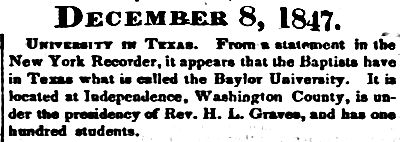
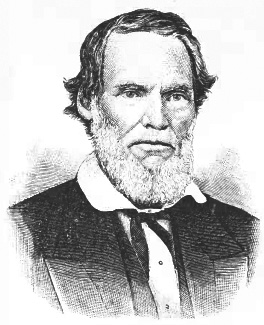 The university was named for Judge Robert Emmett Bledsoe Baylor. (Photo from Wikipedia.)
The university was named for Judge Robert Emmett Bledsoe Baylor. (Photo from Wikipedia.)
Classes began in the community of Independence (Washington County) in May 1846.
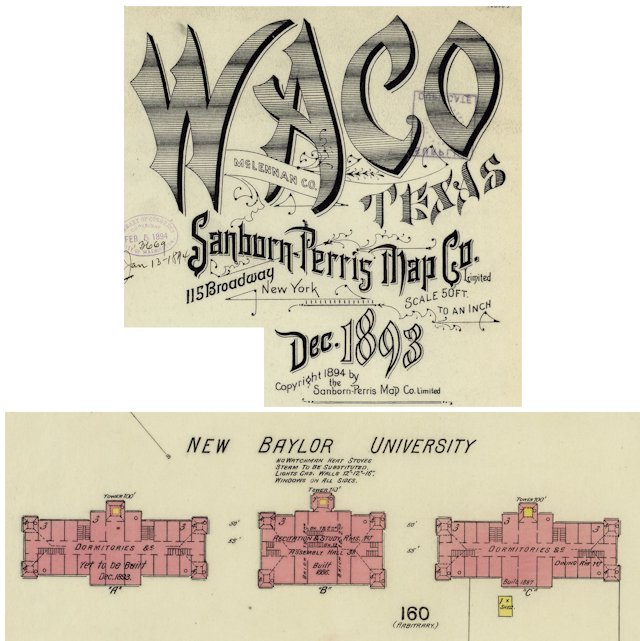 Fast-forward to 1886. Baylor moved to Waco.
Fast-forward to 1886. Baylor moved to Waco.
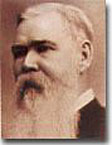 Baylor established a theology department in 1901. In 1905 one of the department’s five professors, B. H. Carroll, elevated the department to the level of seminary: Baylor Theological Seminary. The seminary remained a part of Baylor until 1907, when Carroll, by then chairman of the Baylor board of trustees, recommended that the seminary be chartered as a separate institution. (Photo from Wikipedia.)
Baylor established a theology department in 1901. In 1905 one of the department’s five professors, B. H. Carroll, elevated the department to the level of seminary: Baylor Theological Seminary. The seminary remained a part of Baylor until 1907, when Carroll, by then chairman of the Baylor board of trustees, recommended that the seminary be chartered as a separate institution. (Photo from Wikipedia.)
 Southwestern Baptist Theological Seminary was incorporated on March 14, 1908 with Carroll as president. Among the incorporators was James Bruton Gambrell. Now that the seminary was independent of Baylor, Waco civic leaders accepted that the seminary might move off the Baylor campus, but they assumed that it would remain in Waco.
Southwestern Baptist Theological Seminary was incorporated on March 14, 1908 with Carroll as president. Among the incorporators was James Bruton Gambrell. Now that the seminary was independent of Baylor, Waco civic leaders accepted that the seminary might move off the Baylor campus, but they assumed that it would remain in Waco.
But leaders of the seminary did not feel married to Waco.
 Two weeks after incorporation Carroll spoke at a meeting at Fort Worth’s First Baptist Church. The Fort Worth Record gushed that Carroll was “frequently spoken of as ‘the greatest living Baptist.’” The Record said SWBTS, although freshly chartered, was the second-largest Baptist seminary in the world (after Southern Baptist Theological Seminary in Louisville).
Two weeks after incorporation Carroll spoke at a meeting at Fort Worth’s First Baptist Church. The Fort Worth Record gushed that Carroll was “frequently spoken of as ‘the greatest living Baptist.’” The Record said SWBTS, although freshly chartered, was the second-largest Baptist seminary in the world (after Southern Baptist Theological Seminary in Louisville).
Carroll told his fellow Baptists that the future of the seminary was undecided and that its locating committee soon would select the home of the seminary. He predicted that the seminary within ten years would have an enrollment of one thousand and would spend $500,000 ($14 million today) a year in its host city.
Fort Worth, much smitten, was determined to be that host city. Before the meeting had ended Mayor W. D. Harris read a resolution: “. . . Whereas, we are fully alive to the tremendous blessings and advantages which in moral and religious as well as in commercial life must accrue to the city in which the seminary is located . . . we respectfully propose . . . the city of Fort Worth as a suitable site for the Southwestern Baptist Theological Seminary.”
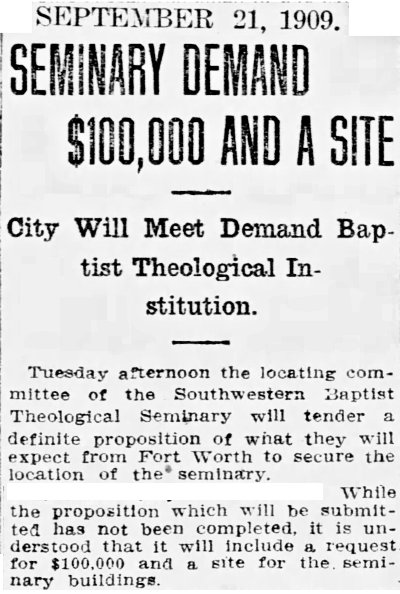 Fast-forward to September 1909. Carroll and the trustees of the seminary were keenly aware of the economic value of their seminary. They did not intend to be a cheap date. To relocate their seminary, they wanted more than flowers, a movie, and dinner.
Fast-forward to September 1909. Carroll and the trustees of the seminary were keenly aware of the economic value of their seminary. They did not intend to be a cheap date. To relocate their seminary, they wanted more than flowers, a movie, and dinner.
They wanted $100,000 ($2.8 million today) and a large tract of land for their new campus.
Fort Worth splashed on some Brut, popped a Tic Tac, swallowed hard, and agreed to raise the money and find the land.
But the seminary had other suitors: Carroll said Dallas also had agreed to raise $100,000. Even poor jilted Waco agreed to raise the money to keep its coy seminary from falling into the arms of another city.
Carroll said he favored Fort Worth because of its location relative to the territory the seminary would serve. Carroll also said that he had gotten the inspiration for the seminary while preaching in Fort Worth.
The seminary even assigned one of its professors, Dr. Lee R. Scarborough, to come to Fort Worth and work with local residents in their effort to win the fair hand of the seminary.
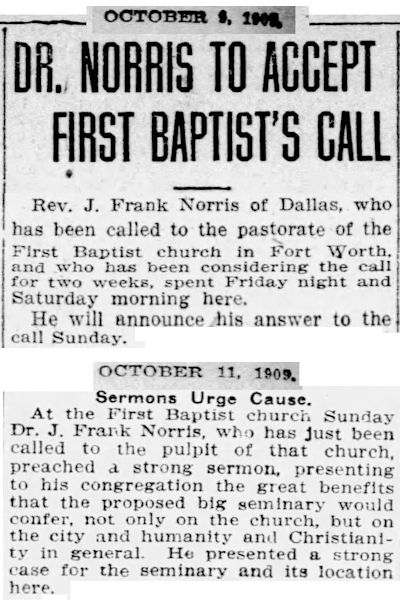 Meanwhile, as Fort Worth set about raising $100,000, J. Frank Norris became pastor of First Baptist Church on October 10 and in his first sermon preached about the benefits that the seminary would confer on the church and the city.
Meanwhile, as Fort Worth set about raising $100,000, J. Frank Norris became pastor of First Baptist Church on October 10 and in his first sermon preached about the benefits that the seminary would confer on the church and the city.
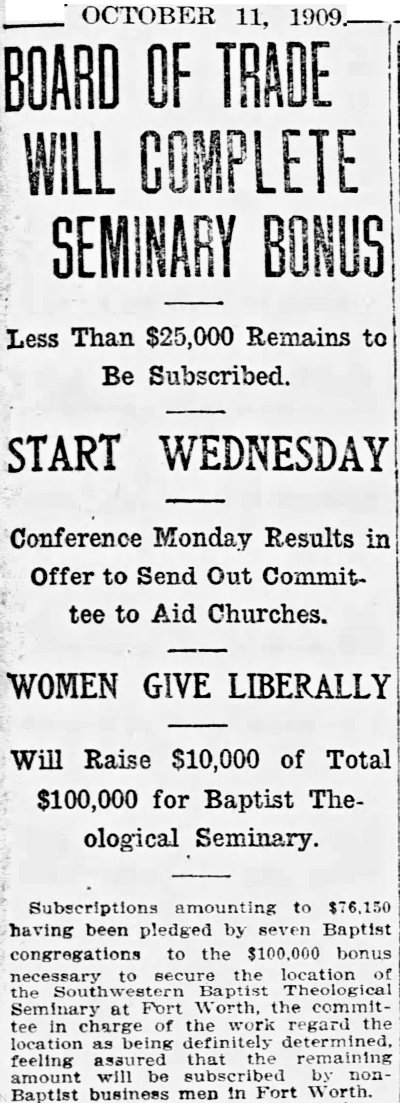 On October 11 the Star-Telegram announced that seven Baptist congregations had pledged $76,000.
On October 11 the Star-Telegram announced that seven Baptist congregations had pledged $76,000.
 Twelve days later the Star-Telegram announced that the $100,000 had been raised, that construction on the first of five campus buildings would begin by January 1, 1910, and that the seminary would open in October of 1910—just thirteen months after Fort Worth began raising the bonus money.
Twelve days later the Star-Telegram announced that the $100,000 had been raised, that construction on the first of five campus buildings would begin by January 1, 1910, and that the seminary would open in October of 1910—just thirteen months after Fort Worth began raising the bonus money.
 The city offered the seminary its choice of five sites for its campus. One site—of 240 acres—was south of town one mile southwest of the “bolt works.” Another was near the interurban line and Polytechnic College on the East Side, offered by George Tandy. Other sites were in Arlington Heights, Polytechnic Heights, and the North Side.
The city offered the seminary its choice of five sites for its campus. One site—of 240 acres—was south of town one mile southwest of the “bolt works.” Another was near the interurban line and Polytechnic College on the East Side, offered by George Tandy. Other sites were in Arlington Heights, Polytechnic Heights, and the North Side.
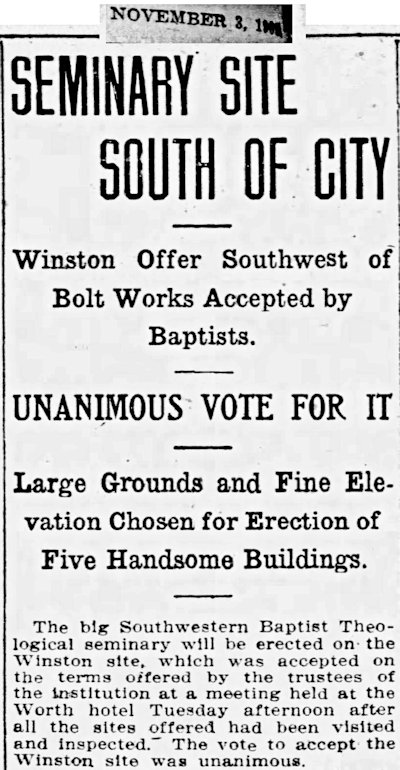 Seminary trustees chose the site southwest of the bolt works, in part because of its “beautiful elevation” and its proximity to the Hemphill Street streetcar line and the Santa Fe railroad track.
Seminary trustees chose the site southwest of the bolt works, in part because of its “beautiful elevation” and its proximity to the Hemphill Street streetcar line and the Santa Fe railroad track.
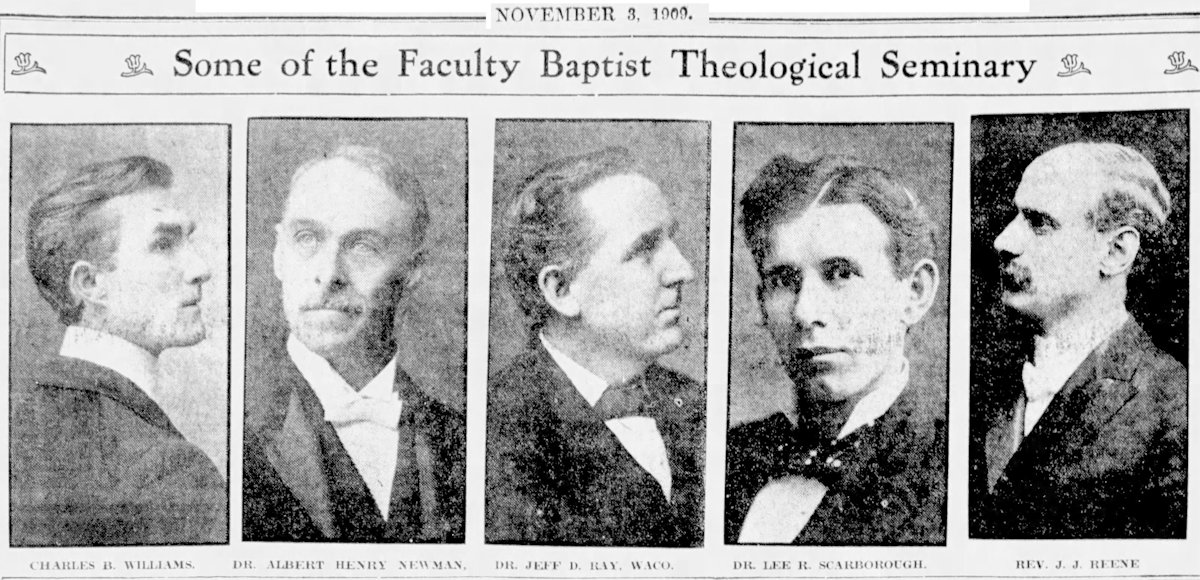 Soon after the deal was secured, the Record printed photos of some of the seminary’s faculty members.
Soon after the deal was secured, the Record printed photos of some of the seminary’s faculty members.
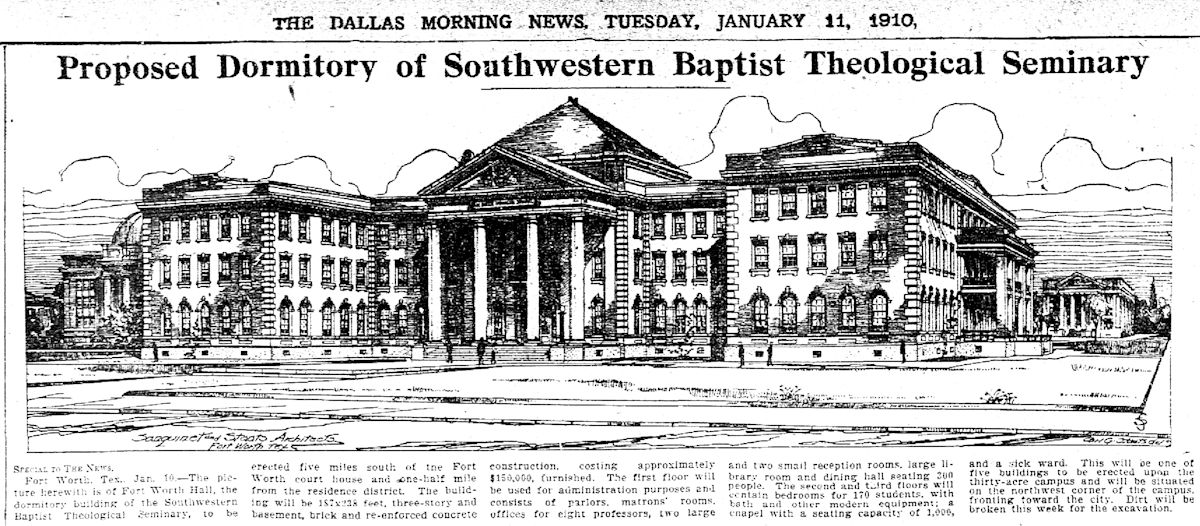 And the Dallas Morning News in January 1910 printed this sketch of the first seminary building planned for construction. The building, designed by Sanguinet and Staats, would house administration offices, dormitory, dining hall, chapel, and sick ward. The building was named “Fort Worth Hall.”
And the Dallas Morning News in January 1910 printed this sketch of the first seminary building planned for construction. The building, designed by Sanguinet and Staats, would house administration offices, dormitory, dining hall, chapel, and sick ward. The building was named “Fort Worth Hall.”
 In 1910 the land donated for the seminary campus was farmland beyond the city limits. But with the prospect of the seminary the surrounding area began to boom. First it acquired a name: Seminary Hill. Then developers such as George C. Clarke began to buy and plat land and sell lots.
In 1910 the land donated for the seminary campus was farmland beyond the city limits. But with the prospect of the seminary the surrounding area began to boom. First it acquired a name: Seminary Hill. Then developers such as George C. Clarke began to buy and plat land and sell lots.
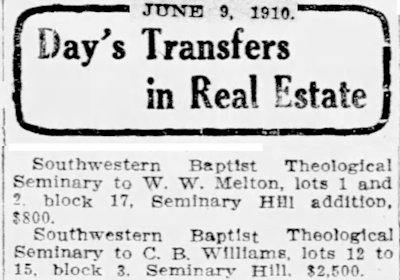 In fact, because the seminary had asked for and received far more land than it intended to use for its campus, the seminary platted some of its surplus land and sold lots.
In fact, because the seminary had asked for and received far more land than it intended to use for its campus, the seminary platted some of its surplus land and sold lots.
On Seminary Hill streets were cut, wells dug, houses built.
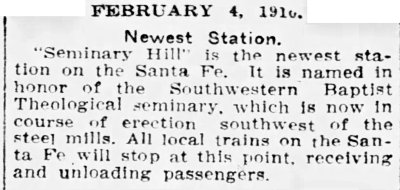 The Santa Fe railroad, whose track passed near the site, built a station at Seminary Hill. Streetcar service would be extended to Seminary Hill in 1912.
The Santa Fe railroad, whose track passed near the site, built a station at Seminary Hill. Streetcar service would be extended to Seminary Hill in 1912.
A suburb was born.
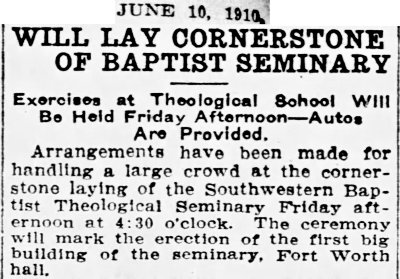 In June the cornerstone for Fort Worth Hall was laid.
In June the cornerstone for Fort Worth Hall was laid.
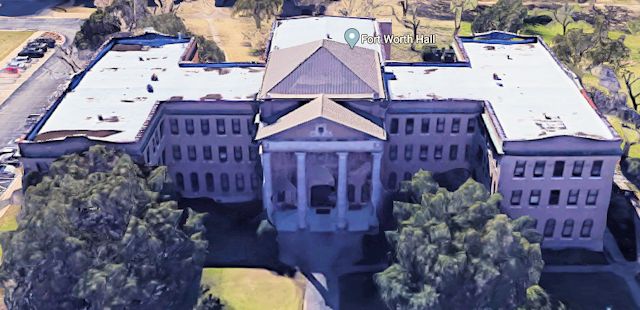 Fort Worth Hall after 112 years.
Fort Worth Hall after 112 years.
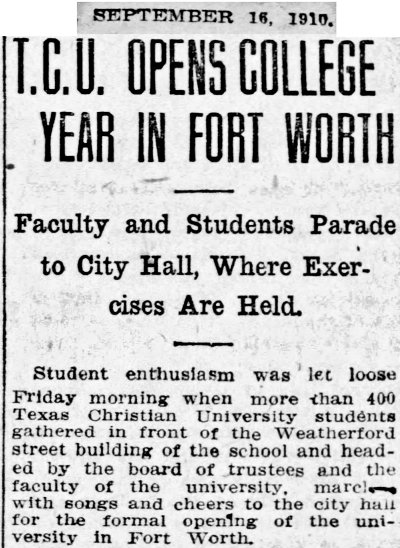 Five miles north of the seminary, on September 16, 1910 Texas Christian University (see Part 1) took the next step in its relocation from Waco as it opened its temporary campus downtown.
Five miles north of the seminary, on September 16, 1910 Texas Christian University (see Part 1) took the next step in its relocation from Waco as it opened its temporary campus downtown.
 Seventeen days later, on October 3, 1910, Southwestern Baptist Theological Seminary opened, although most of its public buildings as well as the homes of its faculty members were unfinished.
Seventeen days later, on October 3, 1910, Southwestern Baptist Theological Seminary opened, although most of its public buildings as well as the homes of its faculty members were unfinished.
The Fort Worth Record declared that with the addition of TCU and SWBTS to Fort Worth’s two colleges (Polytechnic College and Fort Worth University), Fort Worth had become the “educational center of the Southwest.”
One hundred miles to the south, on the banks of the Brazos, people in Waco could only read the headlines and remember the schools that got away.





